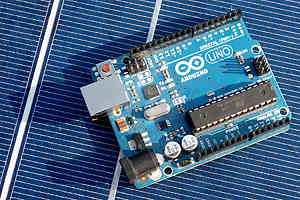 In this post we will talk about some practical topics when it comes to building a real standalone PV system. We know the basic function of the system, about the load, we know the battery basics and selected a battery. We talked about what the PV module does and we looked for a module for our project. We also have a charge regulator. Now we will put this all together and connect the components. Continue reading
In this post we will talk about some practical topics when it comes to building a real standalone PV system. We know the basic function of the system, about the load, we know the battery basics and selected a battery. We talked about what the PV module does and we looked for a module for our project. We also have a charge regulator. Now we will put this all together and connect the components. Continue reading
Monthly Archives: September 2013
Solar power for your arduino – charge regulator
 Our stand-alone PV system is almost complete now: We have the module the battery and our load. Now it’s time to connect the devices. Therfore we need the charge regulator. All other components are connected to it. The charge regulator has two functions: It limits the charging current to get the battery charged in an optimal way and to prevent overcharge. The second function is to cut off the load when the battery runs empty to prevent a deep discharge. This is all done to extend battery’s life. In this post we will look at how these functions are built in hardware and what are the different concepts of charge regulators. We will also talk about choosing the “right one”. Continue reading
Our stand-alone PV system is almost complete now: We have the module the battery and our load. Now it’s time to connect the devices. Therfore we need the charge regulator. All other components are connected to it. The charge regulator has two functions: It limits the charging current to get the battery charged in an optimal way and to prevent overcharge. The second function is to cut off the load when the battery runs empty to prevent a deep discharge. This is all done to extend battery’s life. In this post we will look at how these functions are built in hardware and what are the different concepts of charge regulators. We will also talk about choosing the “right one”. Continue reading
Solar power for your arduino – PV module dimensioning
 We have already defined the electricity consumption (=the load) and the battery size of our standalone PV system. We also know about the electrical characteristics of a solar panel. Now it’s time to determine the size of our panel. This is what we will do in this post. The key to this is the basic function of the system: The PV module has to bring enough energy to keep the system running. This means that the energy from the module must be at least the electricity consumption plus the system losses. Then the system will work. For a calculation we will take the consumption per day. Continue reading
We have already defined the electricity consumption (=the load) and the battery size of our standalone PV system. We also know about the electrical characteristics of a solar panel. Now it’s time to determine the size of our panel. This is what we will do in this post. The key to this is the basic function of the system: The PV module has to bring enough energy to keep the system running. This means that the energy from the module must be at least the electricity consumption plus the system losses. Then the system will work. For a calculation we will take the consumption per day. Continue reading
Solar power for your arduino – PV module basics
 Now that we talked about the basics of a pv system, load, battery basics and selecting a battery it is time for the PV module that gives the system the energy it needs to work. In this post we will discuss the basics of a PV module: Electrical characteristics and how it behaves when irradiation or temperature change. The second part of this post is about testing conditions for PV modules and what the data of the module mean in real life. Continue reading
Now that we talked about the basics of a pv system, load, battery basics and selecting a battery it is time for the PV module that gives the system the energy it needs to work. In this post we will discuss the basics of a PV module: Electrical characteristics and how it behaves when irradiation or temperature change. The second part of this post is about testing conditions for PV modules and what the data of the module mean in real life. Continue reading
